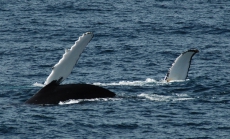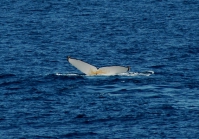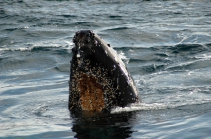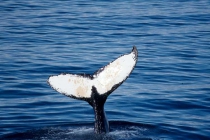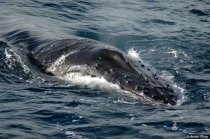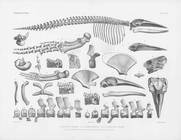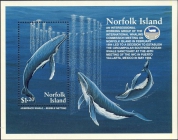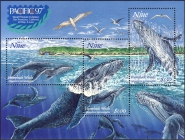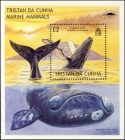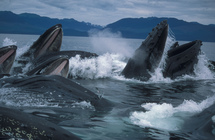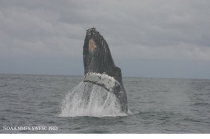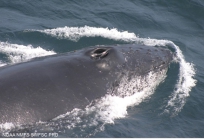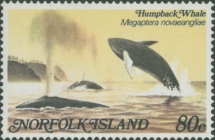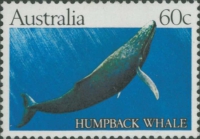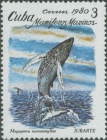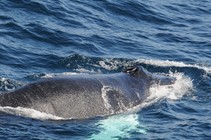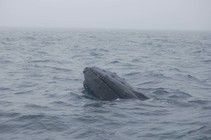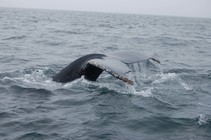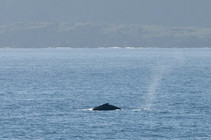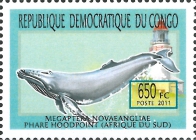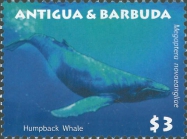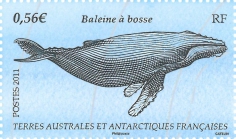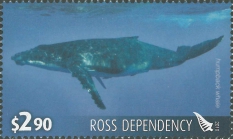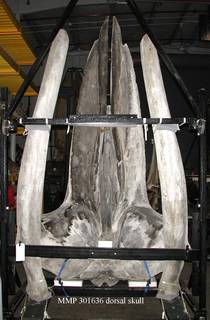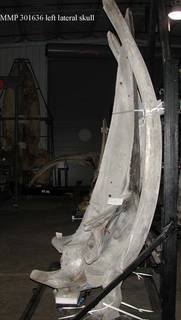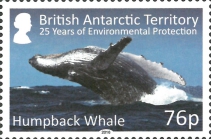
| Intro | | About | | Wiki | | Search traits | | Data explorer | | Literature | | Definitions | | Sources | | Webservices | | Statistics | | Feedback | | Editors | | Log in |
WoRMS taxon detailsMegaptera novaeangliae (Borowski, 1781)
137092 (urn:lsid:marinespecies.org:taxname:137092)
accepted
Species
Balaena allamack Gray, 1846 · unaccepted (synonym)
Balaena atlanticus Hurdis, 1897 · unaccepted (synonym)
Balaena boops Fabricius, 1780 · unaccepted (synonym)
Balaena gibbosa Gray, 1843 · unaccepted (synonym)
Balaena lalandii Fischer, 1829 · unaccepted (synonym)
Balaena longimana Rudolphi, 1832 · unaccepted (synonym)
Balaena nodosa Bonnaterre, 1789 · unaccepted (synonym)
Balaena novaeangliae Borowski, 1781 · unaccepted (basionym)
Balaena sulcata antarctica Schlegel, 1841 · unaccepted (synonym)
Balaenoptera antarctica Temminck, 1841 · unaccepted (synonym)
Balaenoptera astrolabe Pucheran, 1843 · unaccepted (synonym)
Balaenoptera australis Lesson, 1828 · unaccepted (synonym)
Balaenoptera capensis A. Smith, 1834 · unaccepted (synonym)
Balaenoptera leucopteron Lesson, 1842 · unaccepted (synonym)
Balaenoptera syncondylus A. Mueller, 1863 · unaccepted (synonym)
Kyphobalaena keporkak Van Beneden, 1868 · unaccepted (synonym)
Megaptera americana Gray, 1846 · unaccepted (synonym)
Megaptera antarctica Gray, 1846 · unaccepted (synonym)
Megaptera bellicosa Cope, 1871 · unaccepted (synonym)
Megaptera boops Van Beneden & Gervais, 1880 · unaccepted (synonym)
Megaptera brasiliensis True, 1904 · unaccepted (synonym)
Megaptera braziliensis Cope, 1867 · unaccepted (synonym)
Megaptera burmeisteri Burmeister, 1866 · unaccepted (synonym)
Megaptera gigas Cope, 1865 · unaccepted (synonym)
Megaptera indica Gervais, 1883 · unaccepted (synonym)
Megaptera kusira Trouessart, 1904 · unaccepted (misspelling)
Megaptera lalandii Gray, 1864 · unaccepted (synonym)
Megaptera longimana Gray, 1846 · unaccepted (synonym)
Megaptera longimana morei Gray, 1866 · unaccepted (synonym)
Megaptera longipinna Gray, 1846 · unaccepted (synonym)
Megaptera nodosa Bonnaterre, 1789 · unaccepted (synonym)
Megaptera nodosa Lahille, 1905 · unaccepted (synonym)
Megaptera nodosa bellicosa Elliot, 1904 · unaccepted (synonym)
Megaptera nodosa lalandii Tomilin, 1946 · unaccepted (synonym)
Megaptera nodosa nodosa Tomilin, 1946 · unaccepted (synonym)
Megaptera nodosa novaezealandiae Ivashin, 1958 · unaccepted (synonym)
Megaptera novaezelandiae Gray, 1864 · unaccepted (synonym)
Megaptera osphya Mead & Brownell, 2005 · unaccepted (misspelling)
Megaptera osphyia Cope, 1865 · unaccepted (synonym)
Megaptera poescop Gray, 1846 · unaccepted (synonym)
Megaptera versabilis Cope, 1869 · unaccepted (synonym)
Poescopia lalandii Gray, 1866 · unaccepted (synonym)
Rorqualus antarcticus F. Cuvier, 1836 · unaccepted (synonym)
Rorqualus australis Hamilton, 1837 · unaccepted (synonym)
marine,
(of Balaena novaeangliae Borowski, 1781) Borowski, G. H. (1781). Gemeinnüzzige Naturschichte des Tierreichs. <em>G. L. Lange, Berlin and Stralsund.</em> 2: 1-196., available online at https://www.biodiversitylibrary.org/page/28342430
page(s): 21 [details]
Note Coast of New England, U.S.A.
From editor or global species database
Type locality Coast of New England, U.S.A. [details]
Distribution in all oceans
Distribution in all oceans [details] Distribution Antarctica/Southern Ocean; East Pacific; Eastern Atlantic Ocean; Indo-West Pacific; Western Atlantic Ocean
Distribution Antarctica/Southern Ocean; East Pacific; Eastern Atlantic Ocean; Indo-West Pacific; Western Atlantic Ocean [details]
Fordyce, E.; Perrin, W.F. (2025). World Cetacea Database. Megaptera novaeangliae (Borowski, 1781). Accessed through: World Register of Marine Species at: https://www.marinespecies.org/aphia.php?p=taxdetails&id=137092 on 2025-07-16
Date action by
Nomenclatureoriginal description
(of Balaena novaeangliae Borowski, 1781) Borowski, G. H. (1781). Gemeinnüzzige Naturschichte des Tierreichs. <em>G. L. Lange, Berlin and Stralsund.</em> 2: 1-196., available online at https://www.biodiversitylibrary.org/page/28342430 page(s): 21 [details] basis of record van der Land, J. (2001). Tetrapoda, <B><I>in</I></B>: Costello, M.J. <i>et al.</i> (Ed.) (2001). <i>European register of marine species: a check-list of the marine species in Europe and a bibliography of guides to their identification. Collection Patrimoines Naturels,</i> 50: pp. 375-376 (look up in IMIS) [details] Ecologyecology source
Looby, A.; Erbe, C.; Bravo, S.; Cox, K.; Davies, H. L.; Di Iorio, L.; Jézéquel, Y.; Juanes, F.; Martin, C. W.; Mooney, T. A.; Radford, C.; Reynolds, L. K.; Rice, A. N.; Riera, A.; Rountree, R.; Spriel, B.; Stanley, J.; Vela, S.; Parsons, M. J. G. (2023). Global inventory of species categorized by known underwater sonifery. <em>Scientific Data.</em> 10(1). (look up in IMIS), available online at https://doi.org/10.1038/s41597-023-02745-4 [details] Othercontext source (Bermuda)
Sterrer, W. (1986). Marine fauna and flora of Bermuda: a systematic guide to the identification of marine organisms. <em>Wiley-Interscience Publication. Wiley.</em> 742 pp (Nemertini part). [details] Available for editors
context source (PeRMS) Reyes, J. (2009). Ballenas, delfines y otros cetáceos del Perú. Una fuente de información. <em>Lima- Perú. Squema-Ediciones.</em> 160 pp. [details] additional source Mead, J. G.; Brownell, R. L. Jr. (2005). Cetacea. <em>In Wilson, D.E. & D.M. Reeder (eds). Mammal Species of the World. A Taxonomic and Geographic Reference (3rd ed), Johns Hopkins University Press, 2,142 pp.</em> 723--743., available online at http://www.bucknell.edu/msw3/ [details] additional source Rice, D. W. (1998). Marine mammals of the world. Systematics and distribution. <em>Society for Marine Mammalogy Special Publication.</em> 4., available online at http://www.marinemammalscience.org/wp-content/uploads/2014/09/MarineMammalsOfTheWorld.pdf [details] additional source Hershkovitz, P. (1966). Catalog of Living Whales. <em>Bulletin of the United States National Museum.</em> (246): 1-259., available online at https://doi.org/10.5479/si.03629236.246 [details] additional source Jefferson, T. A., M. A. Webber and R. L. Pitman. (2008). Marine mammals of the world. Academic Press, Amsterdam. [details] additional source IUCN Red List of Threatened Species, available online at http://www.iucnredlist.org [details] additional source Perrin, W.F.; Würsig, B.; Thewissen, J.G.M. (2009). Encyclopedia of marine mammals. Second edition. Academic Press: London. ISBN 978-0-12-373553-9. xxix, 1316 pp. (look up in IMIS) [details] additional source Clapham, P. J. and J. G. Mead. (1999). Megaptera novaeangliae. Mammalian Species 604:1--9. [details] additional source Stacey, P. J. and P. W. Arnold. (1999). Orcaella brevirostris. Mammalian Species 616:1--8. [details] additional source King, C.M.; Roberts, C.D.; Bell, B.D.; Fordyce, R.E.; Nicoll, R.S.; Worthy, T.H.; Paulin, C.D.; Hitchmough, R.A.; Keyes, I.W.; Baker, A.N.; Stewart, A.L.; Hiller, N.; McDowall, R.M.; Holdaway, R.N.; McPhee, R.P.; Schwarzhans, W.W.; Tennyson, A.J.D.; Rust, S.; Macadie, I. (2009). Phylum Chordata: lancelets, fishes, amphibians, reptiles, birds, mammals. <em>in: Gordon, D.P. (Ed.) (2009). New Zealand inventory of biodiversity: 1. Kingdom Animalia: Radiata, Lophotrochozoa, Deuterostomia.</em> pp. 431-554. [details] additional source Schmidly, D. J. and B. Würsig. 2009. Mammals (Vertebrata: Mammalia) of the Gulf of Mexico, Pp. 1343–1352 in Felder, D.L. and D.K. Camp (eds.), Gulf of Mexico–Origins, Waters, and Biota. Biodiversity. Texas A&M Press, College Station, Texas. [details] additional source Liu, J.Y. [Ruiyu] (ed.). (2008). Checklist of marine biota of China seas. <em>China Science Press.</em> 1267 pp. (look up in IMIS) [details] Available for editors additional source Maio, N.; Maione, V.; Sgammato, R. (2016). First record of a Humpback Whale Megaptera novaeangliae (Borowski, 1781) in the Tyrrhenian Sea (Cetacea Balaenopteridae). <em>Biodiversity Journal.</em> 7(1): 33-38. [details] additional source Integrated Taxonomic Information System (ITIS). , available online at http://www.itis.gov [details]  Present Present  Present in aphia/obis/gbif/idigbio Present in aphia/obis/gbif/idigbio  Inaccurate Inaccurate  Introduced: alien Introduced: alien  Containing type locality Containing type locality
From editor or global species database
Diet herring (Clupea harengus), sand lance (Ammodytes sp.) and other small fish, invertebrates (euphausiids) [details]Habitat Inshore on feeding and calving grounds, but high seas in transit between them. [details] Holotype None in existence. Name based on the "baleine de la Nouvelle Angleterre" of Brisson (1756). [details] IUCN Red List Category Least Concern (LC) [details] IUCN Red List Category subpopulation Oceania humpback whale : Endangered (EN) [details] IUCN Red List Category subpopulation Arabian Sea humpback whale : Endangered (EN) [details] Morphology Distinguishing characteristics: colour in the northern hemisphere is dark with white belly and on flippers, but southern hemisphere whales have more white. Sensory knobs on head. Lifts tail when diving. Variably curved dorsal fin midback on a hump. "Knuckles" or bumps along tail stock of thin whales. Flippers may reach length of 4.5 m (15'). Individuals recognized by underside of flukes and body scars/markings. [details] Predators Killer whale tooth marks evident on adults; calves probably taken. [details] Type locality Coast of New England, U.S.A. [details] Unreviewed
Dimensions Length: male 36-57 1/2' (11-17.5 m), female 36-62 1/2' (11-19 m), at birth 15'+ (4.6 m+) [details]Distribution in all oceans [details] Distribution Antarctica/Southern Ocean; East Pacific; Eastern Atlantic Ocean; Indo-West Pacific; Western Atlantic Ocean [details] Reproduction Calving: January to March in Caribbean; Weaning: one year [details]
Marine Life Information Network - UK
To Barcode of Life (20 barcodes) To Biodiversity Heritage Library (1 publication) (from synonym Megaptera gigas Cope, 1865) To Biodiversity Heritage Library (1 publication) (from synonym Megaptera nodosa nodosa Tomilin, 1946) To Biodiversity Heritage Library (11 publications) (from synonym Megaptera brasiliensis True, 1904) To Biodiversity Heritage Library (11 publications) (from synonym Megaptera antarctica Gray, 1846) To Biodiversity Heritage Library (11 publications) (from synonym Balaenoptera syncondylus A. Mueller, 1863) To Biodiversity Heritage Library (110 publications) To Biodiversity Heritage Library (13 publications) (from synonym Rorqualus antarcticus F. Cuvier, 1836) To Biodiversity Heritage Library (155 publications) (from synonym Megaptera nodosa Bonnaterre, 1789) To Biodiversity Heritage Library (155 publications) (from synonym Megaptera nodosa Lahille, 1905) To Biodiversity Heritage Library (17 publications) (from synonym Balaenoptera antarctica Temminck, 1841) To Biodiversity Heritage Library (2 publications) (from synonym Balaena atlanticus Hurdis, 1897) To Biodiversity Heritage Library (2 publications) (from synonym Megaptera longipinna Gray, 1846) To Biodiversity Heritage Library (220 publications) (from synonym Megaptera boops Van Beneden & Gervais, 1880) To Biodiversity Heritage Library (25 publications) (from synonym Megaptera lalandii Gray, 1864) To Biodiversity Heritage Library (25 publications) (from synonym Megaptera indica Gervais, 1883) To Biodiversity Heritage Library (256 publications) (from synonym Megaptera longimana Gray, 1846) To Biodiversity Heritage Library (27 publications) (from synonym Balaenoptera australis Lesson, 1828) To Biodiversity Heritage Library (28 publications) (from synonym Megaptera bellicosa Cope, 1871) To Biodiversity Heritage Library (3 publications) (from synonym Balaena novaeangliae Borowski, 1781) To Biodiversity Heritage Library (3 publications) (from synonym Megaptera nodosa bellicosa Elliot, 1904) To Biodiversity Heritage Library (32 publications) (from synonym Balaena gibbosa Gray, 1843) To Biodiversity Heritage Library (33 publications) (from synonym Balaena nodosa Bonnaterre, 1789) To Biodiversity Heritage Library (35 publications) (from synonym Megaptera osphyia Cope, 1865) To Biodiversity Heritage Library (37 publications) (from synonym Megaptera americana Gray, 1846) To Biodiversity Heritage Library (4 publications) (from synonym Balaenoptera capensis A. Smith, 1834) To Biodiversity Heritage Library (4 publications) (from synonym Megaptera burmeisteri Burmeister, 1866) To Biodiversity Heritage Library (5 publications) (from synonym Rorqualus australis Hamilton, 1837) To Biodiversity Heritage Library (5 publications) (from synonym Megaptera braziliensis Cope, 1867) To Biodiversity Heritage Library (6 publications) (from synonym Balaenoptera leucopteron Lesson, 1842) To Biodiversity Heritage Library (6 publications) (from synonym Megaptera nodosa lalandii Tomilin, 1946) To Biodiversity Heritage Library (71 publications) (from synonym Balaena boops Fabricius, 1780) To Biodiversity Heritage Library (76 publications) (from synonym Balaena longimana Rudolphi, 1832) To Biodiversity Heritage Library (87 publications) (from synonym Megaptera versabilis Cope, 1869) To Biodiversity Heritage Library (9 publications) (from synonym Balaena sulcata antarctica Schlegel, 1841) To Biological Information System for Marine Life (BISMaL) To European Nucleotide Archive, ENA (Megaptera novaeangliae) To GenBank (5397 nucleotides; 1112 proteins) To Global Biotic Interactions (GloBI) To IUCN Red List (Least Concern) To NMNH Extant Collection (MMP USNM 301636 Megaptera novaeangliae Dorsal Skull) To NMNH Extant Collection (MMP USNM 301636 Megaptera novaeangliae Left Lateral Skull) To PESI To ITIS From editor or global species database
Unreviewed
|
